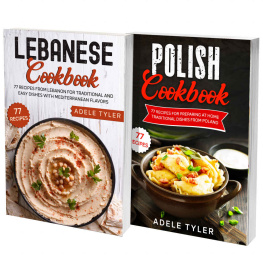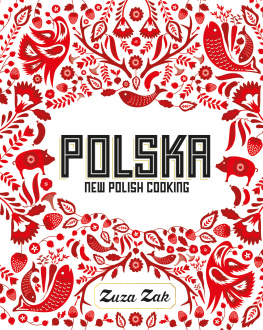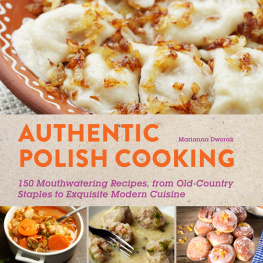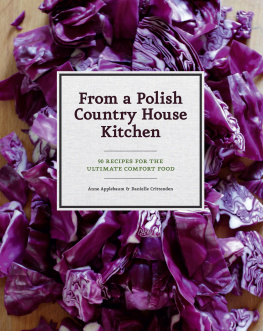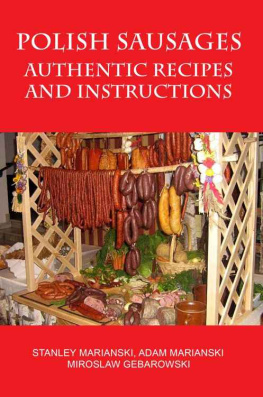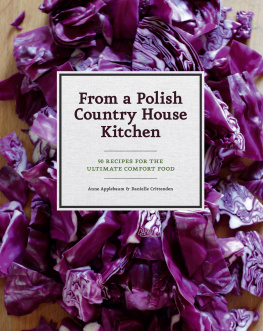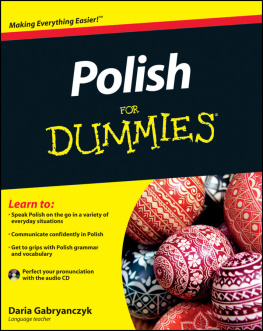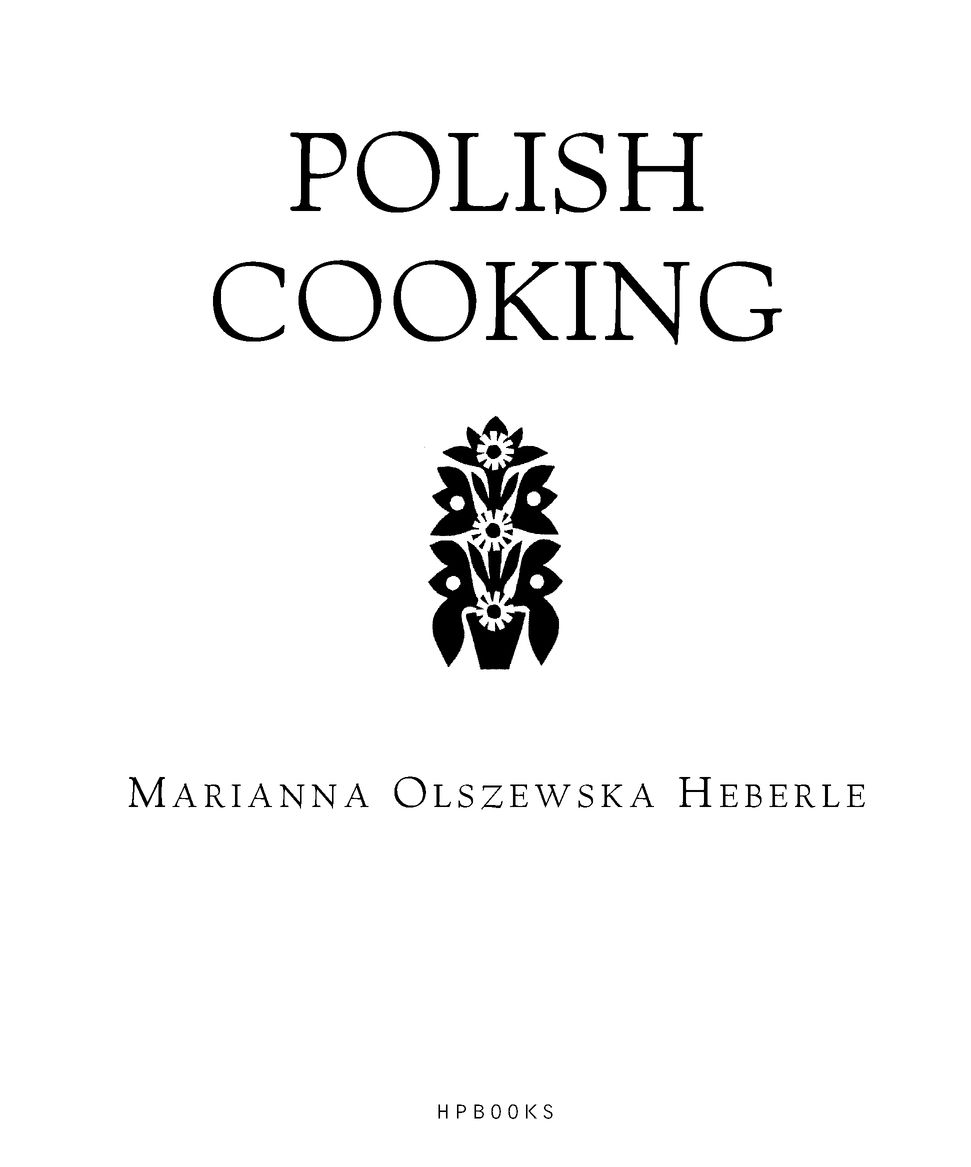Table of Contents
Most HPBooks are available at special quantity discounts for bulk purchases for sales promotions, premiums, fund-raising, or educational use. Special books, or book excerpts, can also be created to fit specific needs.
For details, mite: Special Markets, The Berkley Publishing Group, 375 Hudson Street, New York, New York 10014.
PREFACE
Its been twenty years since the first edition of Polish Cooking was prepared, and a lot has changed since then. Not, however, with most of the recipes withinthey are based on traditions that are, in many cases, hundreds of years old. But change has come to Poland. Poles today are living beneath an umbrella of freedomout from behind the restrictive and repressive influences of the old Soviet Union. Indeed, shortly after the first edition, the communist regimes of many eastern countries started falling like dominoes. Their peoples tasted freedom and democracy and formed exciting new alliances. This political revolution brought major lifestyle changes for much of Eastern Europes
population. My parents and extended family have experienced these changes first-hand. Gone are times of scarce ingredients. Today is a horn of plenty in Poland, with grocery stores and markets featuring foods and ingredients found anywhere else in Europe. Yet Poland has always been a land of strange contrasts, and continues to be so.
Though much of Poland is still rural, its now com- feel free to experiment with its seasonings, cooking mon to see on one side of a street a pair of grandpar- times, and ingredients. ents still living in a homemade masonry and Please, make these recipes yours to keep and thatched-roof dwelling, performing everyday activ- enjoy. ities the same way they did in the early 1900s, Best wishes, while across the street a modern split-level home is Marianna occupied by a younger family enjoying all the conveniences and trappings of modern society, including the most up-to-date computerized kitchen appliances and other labor-saving devices.
Whats different with this edition of Polish Cooking ? Apart from a new format, there are some refinements to the contents. A few recipes contain easy-to-find or substitute ingredients instead of some difficult-to-find ones. But its certainly not a modern version of past editions. It includes over a dozen additional recipes that individuals have repeatedly asked about or requested over the years, and some of my childhood favorites that had not found their way into earlier editions. One such often-requested recipe, Czarnina, which literally translates into Blood Soup but is also known as Duck Soup, is admittedly an exotic-sounding dish, exactly the kind I said in earlier editions would not be found within these pagesbut its really not so unusual, and to leave it out at this point would have disappointed Polish old-timers.
As always, after preparing a recipe from its instructions, the next time you make it,
INTRODUCTION
Welcome to the wonderful world of Polish cuisine! If youve been here before, you know what a delicious experience it is. If youve never ventured within its boundaries, youre in for an enriching surprise.
As a result of catered ethnic wedding receptions and small, late-night neighborhood taverns where frozen, mass-produced pierogies are heated instantly in microwaves, a certain impression of Polish food has developed. Many people of Polish and non-Polish ancestry alike believe that a Polish diet consists entirely of pickles, pierogies, golombkies, duck soup, and kielbasa. Thats like saying the Irish thrive only on potatoes and soda bread, or the Germans on sauerkraut and hasenpfeffer.
Youre going to discover that Polish cookery is not so characteristic as the cuisine of other nations, such as the Chinese, French, or Italian. While steeped in tradition, Polish cooking also has been strongly influenced by outside forces. People are going to eat whatever they like and whatever is available. They dont particularly care if its indigenous to Poland. If they prefer a kind of soup more commonly prepared in Russia, theyre going to eat that without a passing thought as to where the recipe originated. They simply like good food prepared tastefully. Thats what the recipes in this book are all about.
Theyre what the Poles of today are eating. Together, the dishes are representative of the fare found in over 90 percent of the countrys homes and restaurants.
But lest you be deceived, this book is not a catchall encyclopedia of every dish prepared in Poland. During the volumes assembly, equal time was spent deciding which recipes to exclude. The criteria for selecting each dish were that the recipe had to be both appetizing and applicable to todays cook. Detailed instructions for preparing veal head in tomato sauce, or peacock stew may be looked for elsewhere, because its doubtful that such recipes would encourage you to read on. In short, obsolete, unusual (except for one traditional recipe in the soup chapter), or impractical recipes will not be found here.
Its true that for many years Polish cooks had little access to modern kitchen conveniences that we take for granted. Appliances such as microwave ovens, food processors, slow cookers, electric mixers, blenders, and toaster ovens had until recently been all but unheard of by Polish household cooks. Fortunately, the modern cooking age has finally arrived, but it will take quite a while to work its way to mothers and grandmothers who still rely on traditional labor-intensive methods.
I grew up on the outskirts of a small village in northeastern Poland, a few miles from the Russian border. Our small farm, with its barn and stockade fence, was like thousands of others scattered across the Polish countryside. We drew all of our water by hand from a deep outside well, and carried it to the house in buckets. We cooked on cast-iron grates and burners over a firebrick stove fueled with pine wood we cut and split ourselves. Baking and cooking in the oven of a wood-fired stove are much more difficult than in easily regulated gas or electric ovens, because constant temperatures are difficult to maintain with wood heat. Temperatures are high at first, then gradually drop. Some Polish cookbooks even take the gradual temperature drop into account when giving cooking times.
These recipes are simple, straightforward, tasty, and nourishing. And there are a lot more than pierogies and golombkies. Indeed, youre going to find recipes for what both the modern and old-time Poles are eating today. This is a true potpourri of dishes that have evolved over the last ten centuries, fashioned by many influences.
Available Ingredients
Until recently, grocery stores in Poland were not what they were in Chicago, Toronto, London, or Rome. You wouldnt find counters brimming with fresh vegetables, or 23 kinds of frozen fish. Supplies were limited, seasonal, and erratic.
Only a few years ago a Polish butcher might have offered fatback, pork ribs, and a few hanks of sausage. Or he could as easily have had nothing. It all depended. Even the famed canned hams were a myth to most Poles; they had historically been produced almost entirely for export. This is not to say there was no meat. Thousands of homes and mini-farms, even today, are surrounded by neat picket fences that keep chickens, hogs, sheep, goats, geese, and an occasional milking cow from straying. Although locally raised meat is a little easier to come by in rural areas, for many families its still a prized commodity, something to be savored during hard times or on special occasions. And when meat is served, its often extended as a filling, made into patties or cooked with vegetables in a goulash. Leftover bits and pieces find their way into sausage and cold cuts, such as head cheese and scrapple. Bones are saved for soups. Nothing is wasted.




